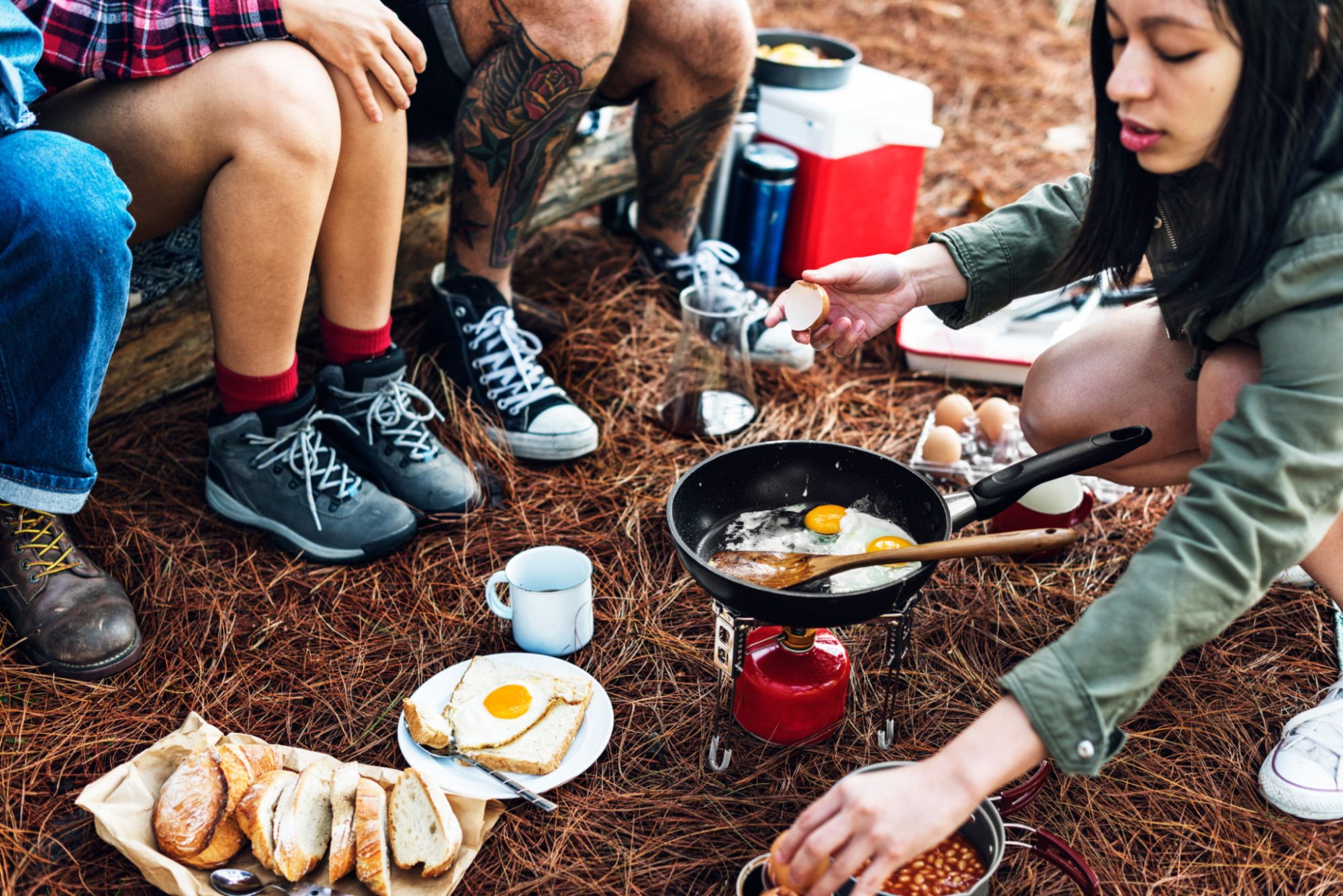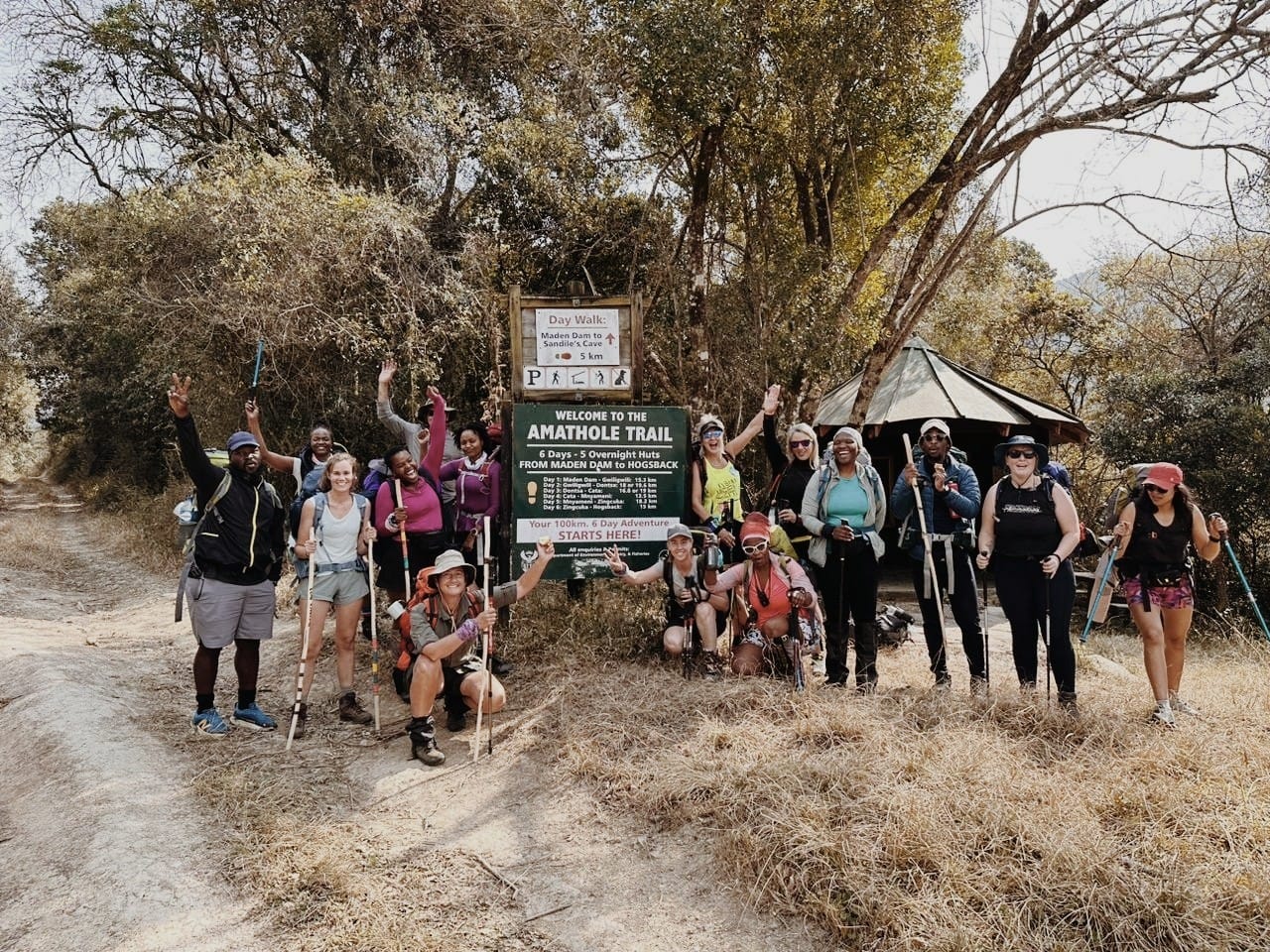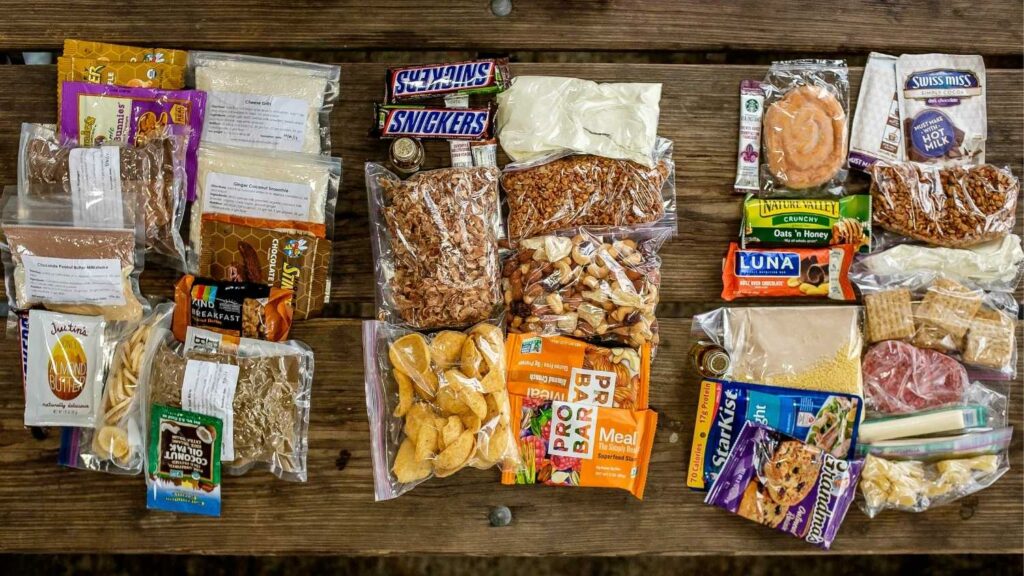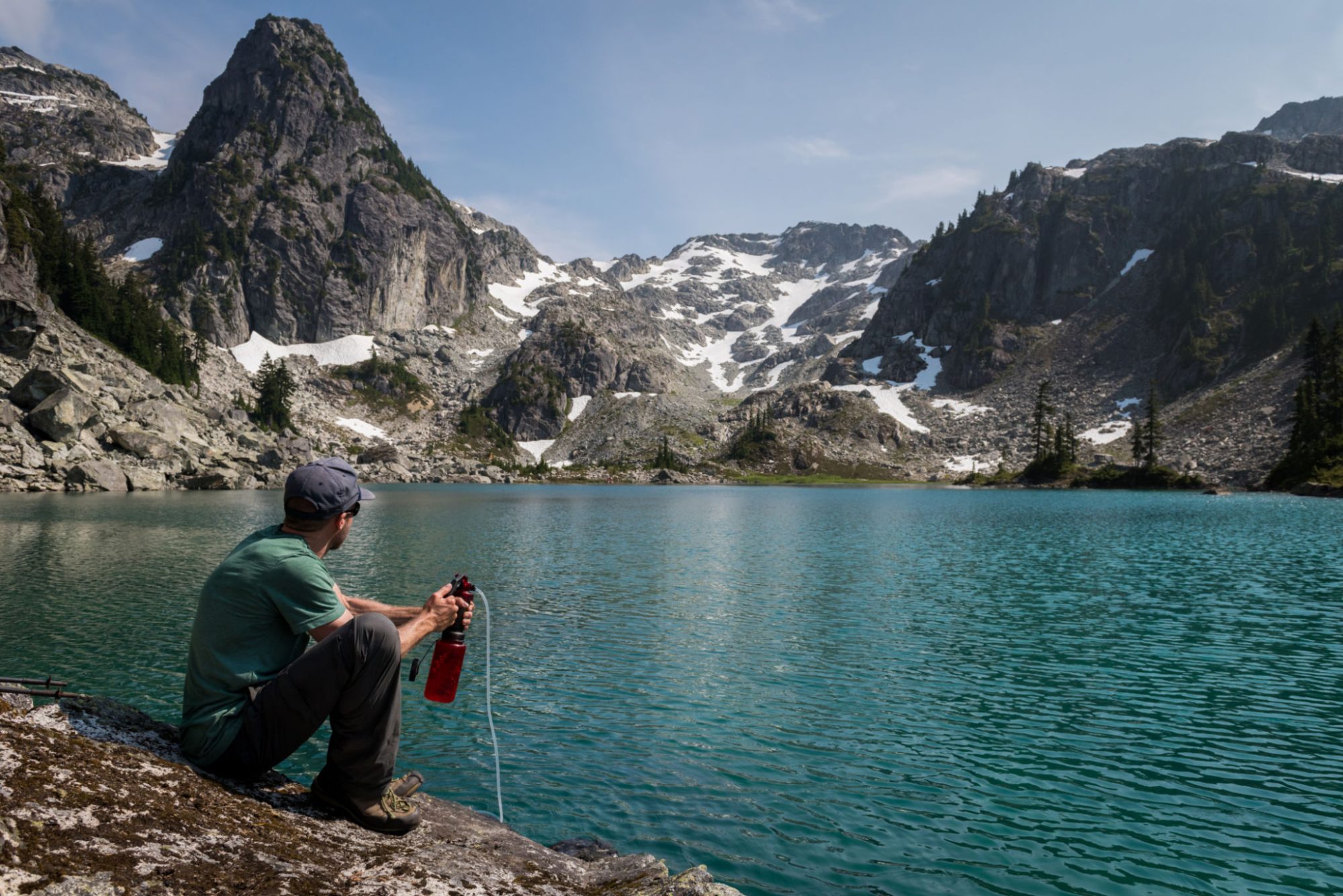Backpacking Food Ideas & Meal Planning
Whether you’re doing a quick overnight trip or backpacking for multiple days, you want food that will nourish and strengthen you, and also taste really good. Here are some quick answers to common questions about meal planning for backpacking trips; we’ll go into more detail below:
- How much food should you take backpacking? It depends, but the short answer is about 2,500 to 4,500 calories of food per person per day.
- What types of food should you bring backpacking? For beginners, keep it simple and choose lightweight, portable foods you know you like to eat.
- What’s a good backpacking meal plan? You should sketch out a rough plan taking into account days when you might not want to cook; to know how much fuel to bring, and to make sure you have enough food to cover all your meals, plus a little extra if needed.
- What are some backpacking meal ideas? The list is truly endless, but we’ll offer a few suggestions below.
Plus, check out our article on how to store and handle food properly while backpacking. And for ultralight backpackers who are conscious about weight, read Meal Planning for Ultralight Backpacking.
How Much Food Should I Take Backpacking?
A question that comes up often is how much food to bring along on a backpacking trip. This will depend on many factors, including the intensity of your activity, your size and weight, how many calories you burn, how many days you’ll be out, and so on.
A reasonable goal is about 1½ to 1½ lbs. of food (or 2,500 to 4,500 calories) per person per day. A person doing 10 miles of strenuous hiking with a 4,000-foot climb will obviously burn more calories—and need a lot more food—than someone covering a few miles of the relatively flat trail who plans to chill at the campsite.
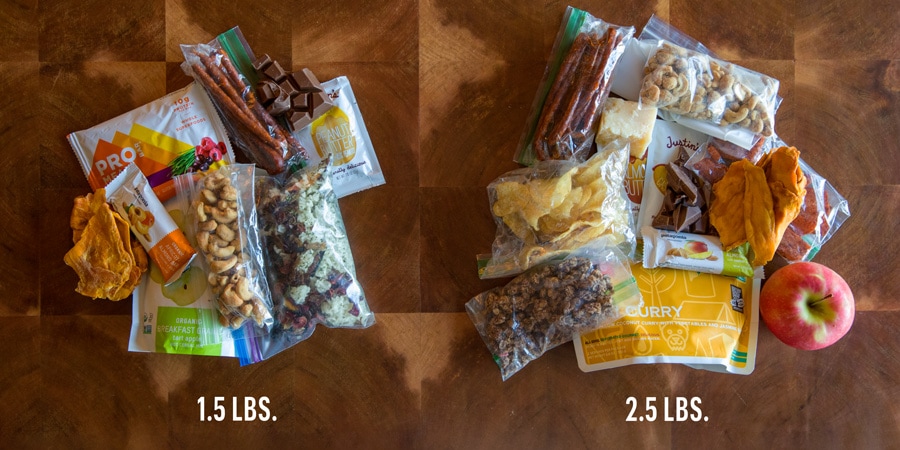
When deciding how much or little to carry, err on the side of taking a little more. One of the Ten Essentials for an overnight trip is a supply of extra food. On the other hand, you won’t want to overdo it. A common blunder is to pack too much food, forcing you to lug unwanted bulk and weight. Experience will teach you what amount of food works for you.
To help you decide how much food to bring, also consider:
- How many days will you be out? Factor in the meal you’ll eat at the trailhead and when you’re done with your trip.
- What is the size of your group? Meals can be much simpler if you’re going solo. If you’re backpacking with others, decide whether you want to share meals. A larger group can split the weight of food as well as fuel and cookware.
- What does your day look like? If you’re clocking many miles over rugged terrain one day, you may want to load up on snacks that you can eat on the go and plan a no-hassle dinner that night.
What Kind of Food Should I Take Backpacking?
You can take most foods backpacking, but it’s best to stick with foods that are portable, lightweight, and not too bulky. Fortunately, there are ways to take backpacking versions of your favorite meal—from burrito bowls to tuna noodle casserole—whether you dehydrate the meal at home, buy ready-to-eat dehydrated meals that only require adding hot water, or assemble your meal from a mixture of fresh and dry ingredients.
When deciding what food to pack, consider these tips:
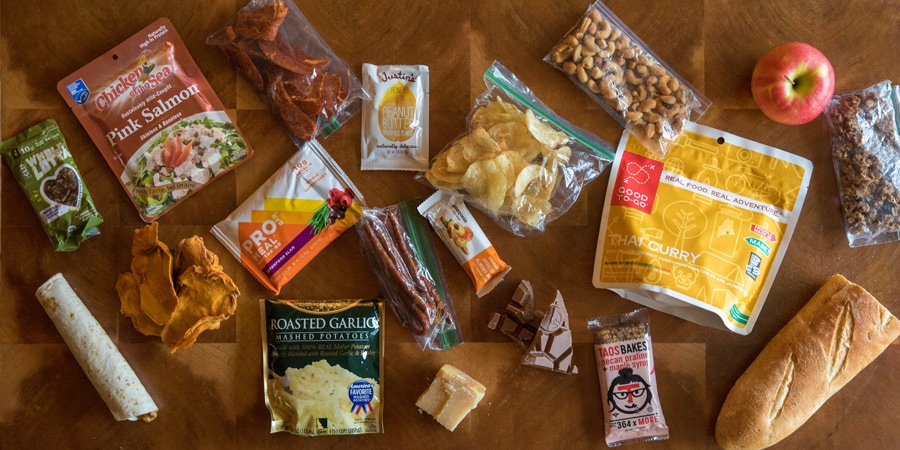
Bring what you like to eat: Don’t try to convert your taste buds to new types of food deep in the backcountry. Take comfort foods that you love to eat and will look forward to enjoying at the end of a long hike.
Pack a variety: A variety of foods is key to keeping most backpackers motivated on the trail. Try to aim for a balance of flavors (salty, sour, sweet, spicy) and textures (soft, crunchy, crumbly, crispy) to keep your palate satiated. Make sure you have a balance of carbohydrates, protein, and fats.
Include some fresh foods: While refrigeration is one of those luxuries you leave behind at the trailhead, not all backpacking food has to be processed or packaged. It’s easy to incorporate some fresh foods into your backpacking menu if you don’t mind a little extra weight. Consider including a baguette, nuts and seeds, and hard cheeses such as parmesan or gouda. It’s also possible to bring some fresh produce: Most fresh foods are good for one day or two inside your pack, depending on the climate. Pick items that won’t perish easily, such as carrots, broccoli, bell peppers, onion, kale, snap peas, apples, or oranges. Read more tips about Eating Right on the Trail and Backpacking Better.
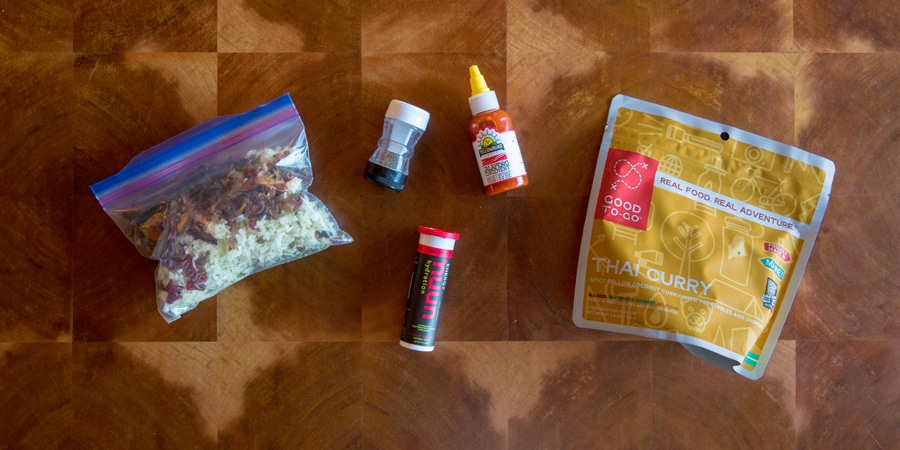
Look for lightweight versions of your favorite food: Macaroni and cheese is a comfort food staple, and boxed versions cook up well in the backcountry. Proteins such as tuna, salmon, Spam, or chicken come in easy vacuum-sealed pouches and are available in most grocery stores. Instant rice, couscous, noodles, pasta, rice mixes, and other shelf-stable boxed dinners are easy choices. Peanut butter is often available in individual servings, pouches, or powdered form.
Add spices: Spices can boost the appeal of backpacking food with minimal additional weight. Don’t be afraid to add it to your meals. Bring salt, pepper, crushed red pepper, cumin, lemon pepper, or whatever else is essential to your home kitchen. Cinnamon makes hot chocolate taste even better. Hot sauce adds zip to mac and cheese. Garlic powder kicks up the taste of instant mashed potatoes.
Stay hydrated with flavored beverages: A hot or cold flavored drink makes it easier to stay hydrated. Beyond fluids with electrolytes, consider hot apple cider, tea, chai, hot chocolate, chicken or beef broth, instant ginger tea, and miso soup.
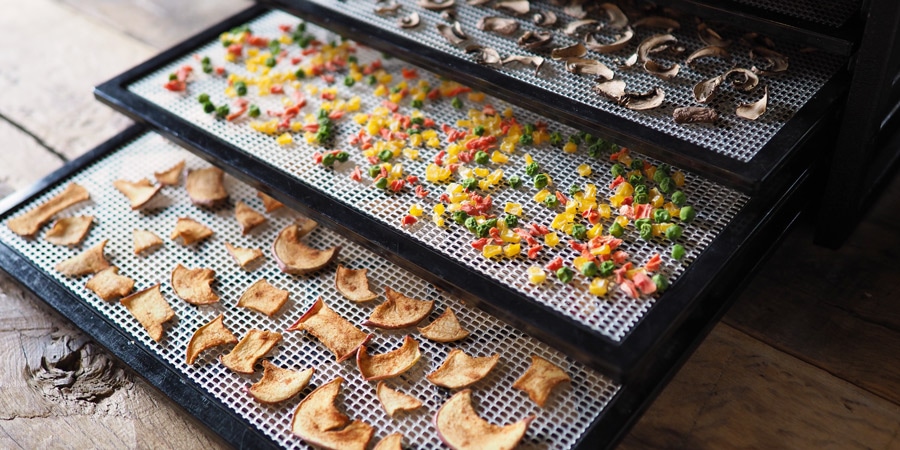
Dehydrate your own meals. While it does take more time and preparation, dehydrating your own backpacking meals can save you money as well as weight and volume in your pack. You can bring your favorite homemade meals and control exactly what goes into them. For a comprehensive guide, read How to Dehydrate Food.
Consider freeze-dried/dehydrated foods: While relatively pricey, these ready-to-eat meals are convenient, require no cleanup, and have a place in many backpacks. Add hot water and wait for the food to rehydrate. The variety of nutritious, tasty choices has expanded over the years and delivers above-average taste and sustenance for the weight. With many more companies making backcountry food, you can find a lot of decent options to suit your taste, even gluten-free and vegan backpacking food.
How to Plan Food for Backpacking
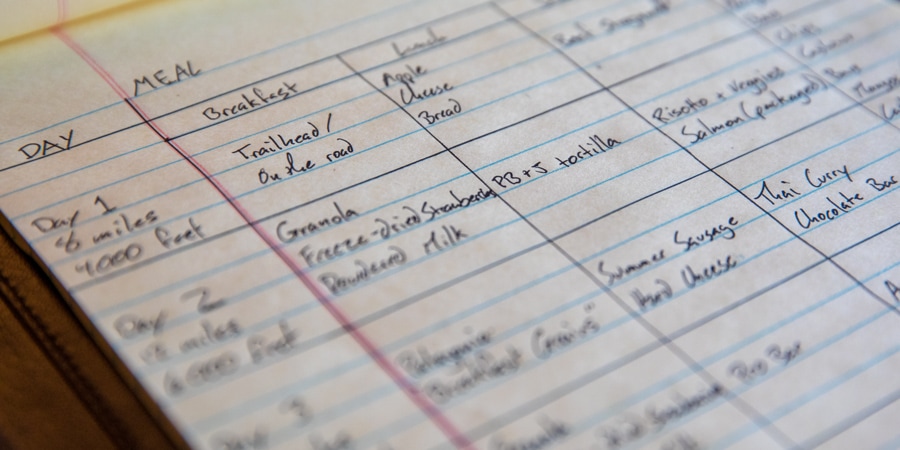
Even if it’s just a rough sketch, it helps to make a meal plan to know how much food you need. This could be as simple as writing it out on paper; or as complex as creating a spreadsheet. Start with dinners, which generally are the biggest meals of the day and the ones you’re likely to sit down for. Think of the activities you’re going to be doing and when you’re doing them. What is your day going to look like and how much energy will you have at the end of it? On your hardest day of hiking, you may want just a simple dehydrated meal. But if your trip includes time lounging around camp, you’ll have more time to prepare.
A sample of food to bring on a 3-day backpacking trip |
|||
|---|---|---|---|
|
Meal |
Day 1 |
Day 2 |
Day 3 |
|
Breakfast |
Breakfast at trailhead |
Pancakes, instant coffee |
Coconut Chocolate Granola, tea |
|
Lunch |
Pita with fresh or dehydrated hummus, fresh bell peppers |
Crackers with cheese, salami |
Tortilla with a foil pouch of tuna, mayo condiment, hot sauce |
|
Snacks |
Dried mango, peanut butter pretzels |
Salmon jerky, M&Ms, sesame sticks |
Banana chips, chocolate-covered cashews, protein bar |
|
Dinner |
Tacos: instant rice or package of cooked rice, instant refried black beans, taco seasoning, cheddar cheese, leftover bell peppers from lunch |
Mushroom Pasta Alfredo |
Coconut Curry Ramen |
|
Dessert |
Apple Crisp |
Tortilla w/ Nutella |
Chocolate bar |
Some people like knowing what they’ll eat each night out – keeping ingredients for each meal together and labeling the meals by the day. This helps ensure they’ll have enough food for each day out. Others just throw their food in one bag and decide on the go what to eat. If you want to include fresh food on the trail such as fruits and vegetables, eat it earlier in the trip (to lighten your load and prevent it from wilting or spoiling). Include an easy freeze-dried or dehydrated meal that you just add water to for those days when you have a lot of mileage to cover and may be too tired to cook.
As you’re planning your meal, also consider:
- Make sure you have access to water: This can vary greatly depending on where you’re going and can influence what backpacking food you choose to bring.
- Be aware of the fuel you will need and cook times for foods such as pasta, potatoes, rice, quinoa, etc. and make sure to plan for enough fuel (some of these dishes take a deceptively long time to cook). Pancakes will also take more fuel. Read our article on how to decide how much fuel to bring.
- Weigh costs: Freeze-dried meals and energy foods are convenient but can be expensive. If you’re planning multiple nights out or several trips, buy food in bulk. As mentioned above, also consider dehydrating your own food.
Where to Buy Food for Backpacking
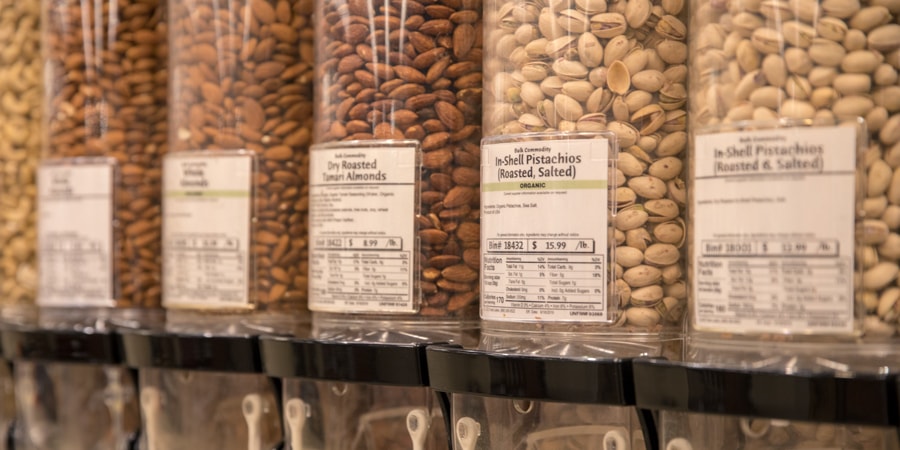
Shop at outdoor retail stores closer to you for backpacking food, including dehydrated or freeze-dried meals, snacks, beverages, and energy food.
Scan grocery stores for small packets of foods such as tuna pouches, oil packets, powdered milk, or small packages of peanut butter or jelly. Also look for ramen noodles, instant rice, soup mixes, chicken or beef bouillon, instant mashed potatoes, or dehydrated hash browns. Don’t overlook the international food aisle for instant noodles, instant refried beans, and other boxed meals.
Look in the bulk food sections for snacks, instant hummus, vegetable soup mixes, black bean flakes, powdered milk, powdered butter, instant falafel mixes, and so on.
Backpacking Food Ideas
Breakfast
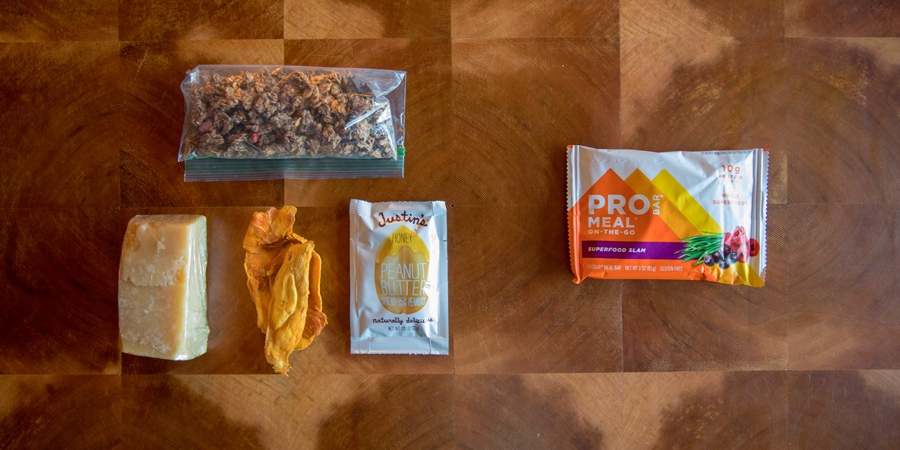
Backpacking breakfasts can range from fast and basic (an energy bar) to a lavish spread involving pancakes, eggs, meats, and coffee. A hot meal can give you an extra boost, but a light snack means no cleanup and a quicker start to the day.
Backpacking breakfast ideas: Instant hot cereal or oatmeal with dried fruits and nuts; rolled oats soaked overnight in water; powdered or fresh scrambled eggs in a tortilla; savory pancakes; breakfast bars; apple quinoa porridge; Pop-Tarts; granola or cereal with powdered milk; instant mashed potatoes or instant hash browns; instant grits with bacon bits or cheese; self-stable or precooked bacon.
Snacks
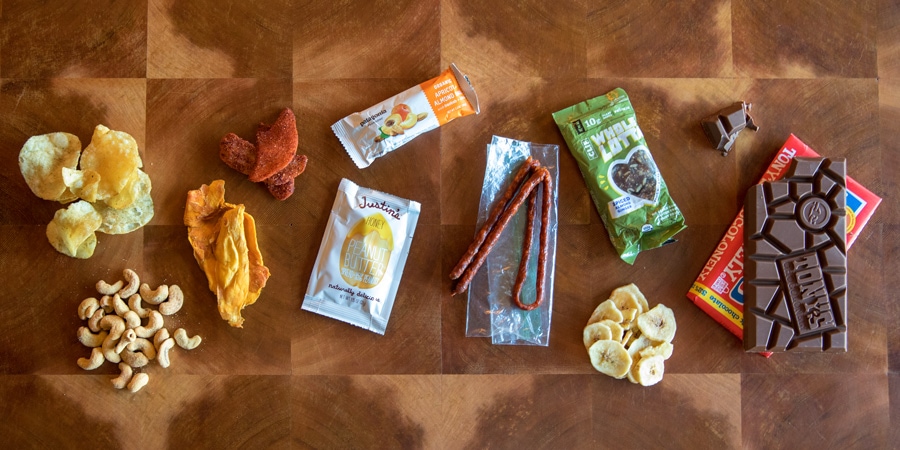
Snack ideas: Trail mix is a go-to for many, but the list of tasty snack options is expansive. Banana chips, no-bake energy bites, chocolate-covered cashews or almonds, spicy nuts, dried fruit (apples, mangos, cranberries), fruit leather, string cheese, crackers, fig bars, peanut butter pretzels, cookies, Chex mix, sesame sticks, pumpkin seeds, gummy bears, licorice and candy bars are just a few choices. For more ideas, read Snack Hacks for Any Outdoor Adventure.
Lunch
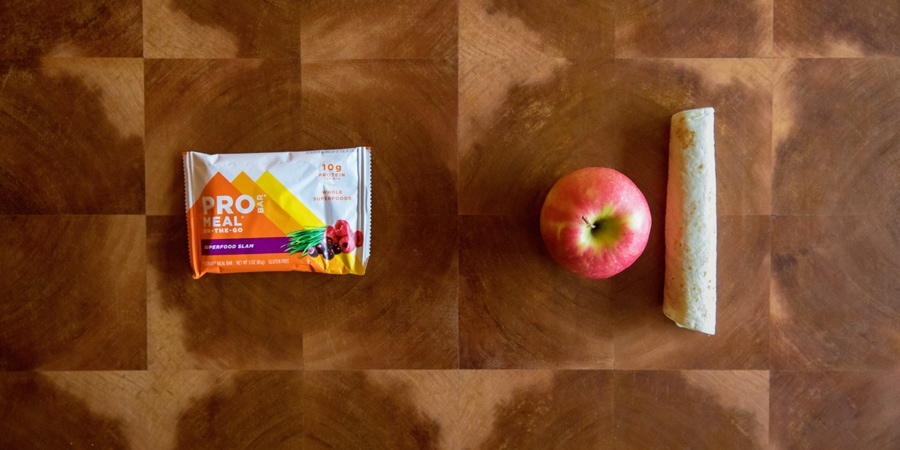
Some backpackers like to stop and sit down to have lunch while some keep it simple with a few protein bars as they hike. Others graze on a string of snacks throughout the day.
Backpacking lunch ideas: Jerky; peanut butter and jelly in small tube containers; energy bars; dried fruits; nuts; sandwich thins with tuna; tortillas with peanut butter; pita with dehydrated or fresh hummus or hummus bowl; bagels with cream cheese; summer sausage and cheese; crackers with smoked salmon; ramen noodles; string cheese with salami; premade sandwich.
Dinner
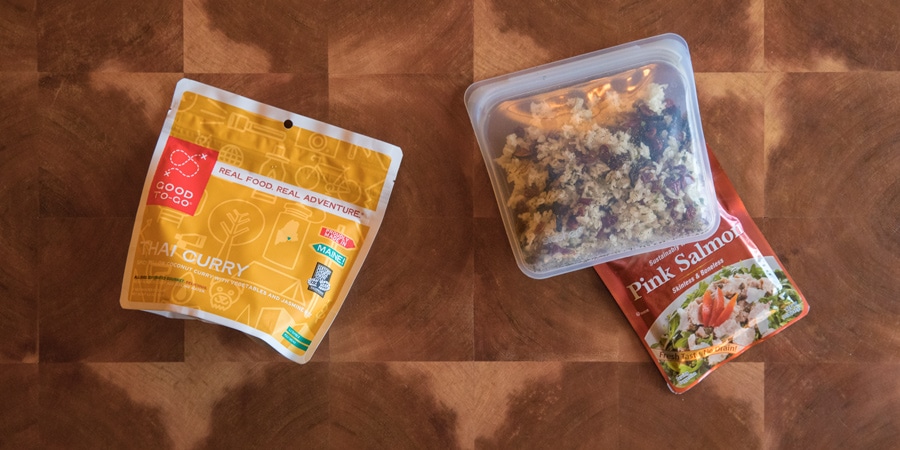
This is your reward for a day of exertion. Backcountry gourmets don’t mind the extra challenge of creating hearty meals out in the great scenery. Most weary backpackers, though, opt for the just-add-boiling-water convenience of prepackaged freeze-dried or dehydrated meals, or simple dishes such as pasta.
Backpacking dinner ideas: Macaroni and cheese with bacon bits or tuna; dehydrated risotto; pasta with pesto and parmesan cheese; ramen noodles with dehydrated vegetables; instant soups; instant mashed potatoes and beef jerky; instant stuffing with cooked chicken (pouch or fresh); backpacking Thanksgiving dinner. To assemble other easy meals, pick a starch such as instant rice or couscous; then pick a protein, whether it’s tuna, salmon, chicken, or TVP protein; then add fresh or dehydrated vegetables and spices.
Other Backpacking Meal Tips
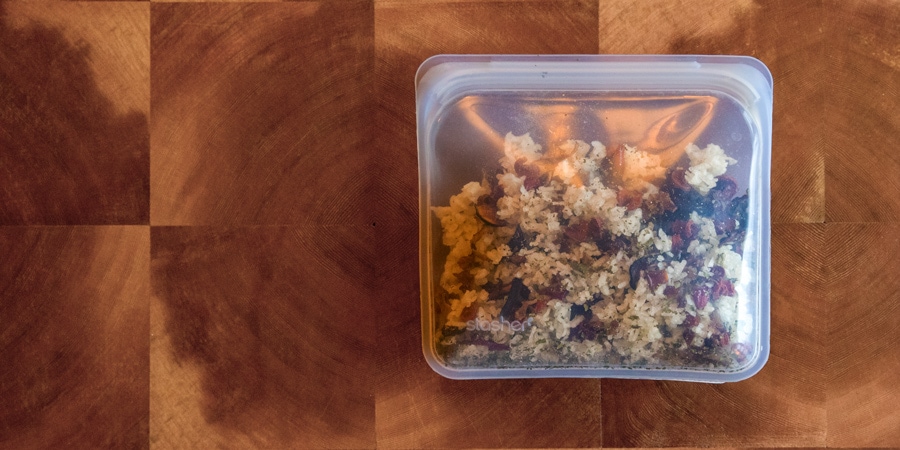
Consider repackaging foods into resealable and reusable pouches or containers to minimize bulk and garbage. Be sure to clearly label everything and include cooking instructions.
Test out recipes at home: Just as it’s good practice to test out your stove or tent at home first, try new potential backpacking recipes at home. While trail food always magically tastes better on the trail, practice can give you an idea of how much effort it will be to make, cooking time, and adjustments you might want to make for taste. Invite some friends over, have a backpacking cooking competition, and have fun with it.
Save a special treat: It’s nice to have a dessert or a special treat to wrap up your day. A freeze-dried raspberry crumbles or bar of good dark chocolate can keep you motivated.
Take a class: Learn the basics of backcountry cooking from the experts.


